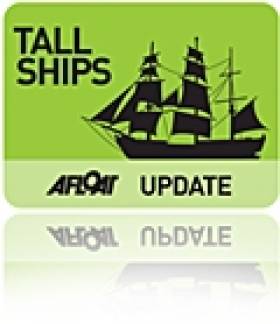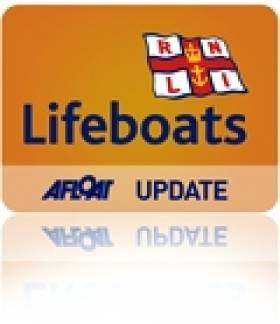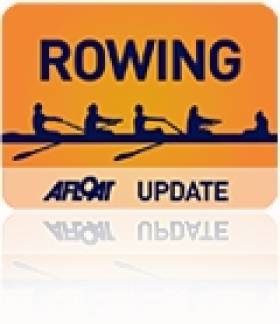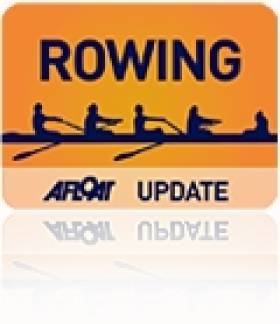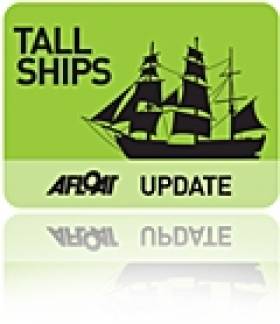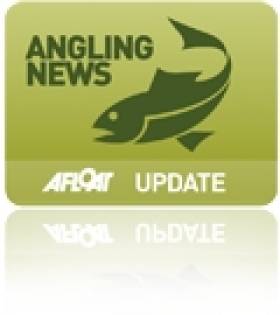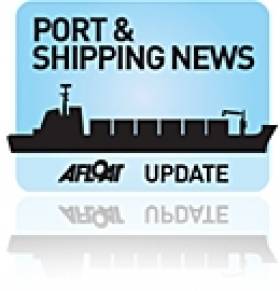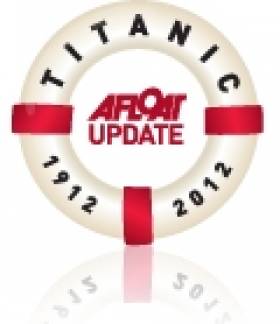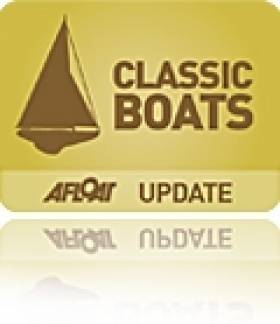Displaying items by tag: Belfast
#tallship – The visit of the Tall Ships to Belfast from July 2nd to 5th was anticipated with an enthusiasm which was fully justified by the numbers which became involved. Sixty vessels of all sizes assembled on both sides of the River Lagan in the rejuvenated docklands area and the Titanic Quarter, with a goodly sprinkling of the Class A full-rigged ships dominating the scene. And in a well-organised shoreside transport scheme involving Park & Ride centres in the suburbs, the people were able to get to the clean new quaysides in their thousands, in their tens of thousands, in their hundreds of thousands – indeed, it's reckoned that when those who clustered along the shores of Belfast Lough to watch yesterday's departing Parade of Sail are added in, well over half a million people were involved.
At the many events in Belfast Docks, organisers Sail Training International reported that the number of people making a point of personally going aboard one of the Tall Ships was unprecedented at any port since the international programme was launched way back in 1956, underlining the great interest there is in these ships, and what they do. In future discussions on Afloat.ie, we'll be looking at how the success of this event will affect the re-development of a proper sail training programme in Ireland north and south. But for now, with the Sail Training Races 2015 started this afternoon off Portrush on the north coast after the fleet had sailed there from yesterday's departure from Belfast Lough, W M Nixon recalls some memories from the Parade of Sail.
It's something of a triumph of hope over experience expecting to see fleets of Tall Ships becoming veritable Cathedrals of Sail when they're proceeding seaward for their first race after several days of assembling and partying like crazy in some hospitable port. Even with the ten or so miles of open water which Belfast Lough provided before the boats headed into the North Channel yesterday afternoon to proceed to today's start of the Tall Ships first race of the 2015 programme to Alesund in Norway, there's little enough room for the biggest ships to start shaking out the canvas and engaging in anything approaching close quarters manoeuvring.
Then too, in some cases Belfast will have seen crew changes, and the ship's officers – who may themselves just be ever so slightly partied out – will be reluctant to put fresh untested crewmen through all their paces in the first day out, and all of it under observation from boats large and small tearing about the lough on spectator missions.
But even without sail set, the best-looking big ships really are astonishingly handsome. As two of the ports for this year's programme are in Norway, the Norwegians were putting on the style with the presence of three famous full-rigged ships – the Christian Radich, the Sorlandet, and the Statsraad Lehmkuhl. They'll have left Norway in pristine condition, and clearly their crews were determined to keep them that way for the return home, as their square sails remained resolutely neat, tightly furled as a stockbroker's umbrella, with the ships setting only two or three staysails as they proceeded primly down the laugh.
 Superbly presented....but setting no square sails – two of the Norwegian biggies, with Sorlandet in the foreground. Photo: W M Nixon
Superbly presented....but setting no square sails – two of the Norwegian biggies, with Sorlandet in the foreground. Photo: W M Nixon

The elegant stern of the Statsraad Lehmkuhl was a joy to behold Photo: W M Nixon
Fortunately we'd the people's choice star of the show to brighten things, the Ecuadorian ship Guayas, game for anything with all sail eventually set, and the usual vast Latin American ensign flying from the mizzen. Guayas is on her first round the world cruise, and she must have been away from home for quite some time already. Let's put that another way. If any international marine paint manufacturer happens to be reading this, may we suggest that you could do yourself a lot of good in worldwide PR by donating many gallons of fresh white paint to the good ship Guayas. Nevertheless if there was an award for party spirit, Guayas would have won it easily.
In terms of square riggers setting the cloth, once again it was the Dutch who set the pace, this time the most enthusiastic being the Morgenster, which is a favourite among Irish trainees. She had her sails up and drawing while still in the Lagan, and looked the part at every stage.

The popular Morgenster had her square sails set before she cleared the river. Photo: W M Nixon
 A Ballyholme Laser sailor takes on the French schooner Etoile – and he kept up with her too.....Photo: W M Nixon
A Ballyholme Laser sailor takes on the French schooner Etoile – and he kept up with her too.....Photo: W M Nixon
Also quickening many an old salt's heart was the French tops'l schooner Etoile, which with her sister-ship Belle Poule has been sail training French naval cadets for longer than any of us can remember (it's 1932, as it happens) and she continues to be a tidy and manageable size which might be an inspiration for those who think Ireland doesn't absolutely have to have her own Class A vessel.
In terms of vessel numbers, it was of course the smaller fore-and-aft craft which made up the crowd, and observing from aboard the hospitable Peter & Carolyn Minnis's Mitchell 31 powercruiser Blue Echo, our group was particularly taken with the team spirit shown by the cheerful crew on the London-based Oyster 80 Rona II.
As for the presence of the eternal Jolie Brise, those of us who knew that this remarkable vessel was the winner of the first Fastnet Race ninety years ago still find it a wonder to behold the way such a hefty vessel can slip through the water, while those who were seeing the splendid old cutter for the first time were much taken with the Fastnet links.

The eternal Jolie Brise – this winner of the first Fastnet Race ninety years ago continues to impress with her stylish way through the water. Photo: W M Nixon
 Back to life – the superbly restored Huff of Arklow revelling in the sailing on Belfast Lough. Photo: W M Nixon
Back to life – the superbly restored Huff of Arklow revelling in the sailing on Belfast Lough. Photo: W M Nixon
Equally impressive in her way was the restored Huff of Arklow, the Flying Thirty first built by Jack Tyrrell of Arklow in 1951 to an Uffa Fox design, and now brought back to vigorous new life by Dominic Bridgeman and his group down Plymouth way. She's due back in her first home port of Dun Laoghaire on Wednesday to be an adornment of the Volvo Dun Laoghaire Regatta 2015 and we'll look at her in more detail in the near future, but meanwhile rest assured that she cut a real dash in Belfast Lough on Sunday.
And finally, with the fleet now on their way towards Norway from today's start area off Portrush, it was more than appropriate that the last little boat we diverted towards for have a looksee was the classic Greencastle yawl James Kelly, built by Robin Ruddock and his maritime heritage group in Portrush in honour of the great local boatbuilder who, between 1895 and 1910, built many notable craft including three Dublin Bay 21s and seven Howth 17s. The James Kelly is one jaunty little craft, and she was sailing like a witch.

Gallant little boat. The Greencastle yawl James Kelly was brought down from Portrush to salute the Tall Ships on Belfast Lough. Photo: W M Nixon
#RNLI - The RNLI will have a fully operational lifeboat station in Belfast City from 9am tomorrow 2 July right through to Sunday evening 5 July for the Tall Ships Races.
With up to 750,000 visitors expected in Belfast over the next four days, a number of volunteers from Bangor and Red Bay lifeboat stations will be on call to provide a 24-hour search and rescue service during the event.
The crew will operate from a temporary lifeboat station located in Belfast Harbour Marina and will respond to any emergency on Belfast Lough using an Atlantic 85 relief lifeboat.
During the Tall Ships Parade on Sunday, both the Atlantic 85 lifeboat and an all-weather Trent class lifeboat crewed by Donaghadee RNLI will be operational on Belfast Lough for search and rescue capabilities.
Speaking ahead of the Tall Ships Races, RNLI divisional operations manager Darren Byers said: "For the duration of the weekend and specifically to accommodate the large numbers expected to descend on Belfast to watch the Tall Ships spectacle, the RNLI will be fully operational at the heart of where all the activities will be taking place.
"Belfast RNLI will operate for four days only supported by its nearest lifeboat stations at Bangor and Larne. This means should there be an emergency during the event, we can reduce the time it takes to get on scene while maintaining a business as usual operation at our flank lifeboat stations."
The RNLI will have a significant presence on site throughout the weekend and has been honoured to be chosen by Tall Ships Belfast as one of five key maritime charities to benefit.
As well as a fully operational lifeboat station, the RNLI will have an all-weather Trent class lifeboat afloat which can be viewed from the quayside at Belfast Harbour Marina. Volunteer lifeboat crew will be on hand to answer any questions and to demonstrate how they use the lifeboat for search and rescue.
RNLI lifeguards who patrol 10 beaches in Northern Ireland during the summer season will also be displaying the rescue water craft and lifesaving kit they use.
Visitors to the RNLI areas can also take part in the ‘Get Your Kit on Challenge’. This is a timed challenge that pits members of the public against the clock to see how long it takes them to put on an inshore lifeboat crew member’s full kit: dry suit with yellow wellies, lifejacket with crotch straps and helmet. The lifeboat crew do this in seconds as they race to launch the lifeboat on a callout.
RNLI community fundraising manager Nicola Kelly is looking forward to the event. "The RNLI is hosting a variety of engaging activities at Tall Ships Belfast and we are honoured to have been selected as one of the official charities to benefit," she said.
"We are looking forward to welcoming visitors to the RNLI areas and hope that in doing so we can provide an entertaining, informative and interesting aspect to the full programme being provided.
"As well as saving lives at sea and on inland waters, the RNLI also provides education along with sea safety advice and demonstrations and we hope spectators can sample a flavour of that this weekend."
#Rowing: UCC’s young crew did not make it through to the main draw at Henley Royal Regatta. In the qualification races tonight they finished 12th of the 25 non-qualifiers for the Prince Albert for student coxed fours, setting a time of seven minutes and exactly 36 seconds. The Belfast Rowing Club crew which had hoped to make it through in the Wyfold for club fours also lost out. Separate to the qualifiers, Alan Campbell was listed as withdrawing from the draw from the Diamond Sculls.
Henley Royal Regatta, Qualification Races (Irish interest)
Wyfold (Four, Club): Belfast RC 7 mins 41.3, did not qualify
Prince Albert (Coxed Four, Student): UCC 7:36, did not qualify
Trinity and Portora Enter Eights for Henley Royal Regatta
#Rowing: Ireland’s entry for Henley Royal Regatta is again relatively small this year. Trinity and Portora Royal School have entered eights, while Lady Elizabeth Boat Club and Belfast Rowing Club have both entered Wyfolds fours. UCC have entered a coxed four for the Prince Albert Cup. Qualifying races take place on Friday, June 26th; while the regatta starts on Wednesday, July 1st.
Henley Royal Regatta Entries (Irish interest)
Temple Cup (Eight, Student): Trinity College, Dublin
Princess Elizabeth (Eight, Schoolboy): Portora Royal School
Wyfold Cup (Four, Club and University): Lady Elizabeth; Belfast Rowing Club
Prince Albert (Fours, coxed, Student): University College, Cork
Diamond Sculls (Single, Open): A Campbell
Tall Ships Belfast To Raise Money for Charity
#tallshipsbelfast – Sailing and maritime charities are to raise cash from the big summer Tall Ships Spectacular in Belfast this July. The Tall Ships Company Ltd has appointed five key charities who will benefit from the event, according to the Belfast Telegraph. The charities are RNLI Lifeboats, Ocean Youth Trust, The Mission to Seafarers, Sea Cadet Corps and Belfast Lough Sailability.
This is the first time individual charities will be working as a collective and will be holding a variety of fundraising activities leading up to and during the three day extravaganza in Belfast from 2nd to 5th of July.
"It's an amazing event for any city to have," said Gerry Copeland, Belfast City Council City Events Manager.
"In 2009 at the Tall Ships event there were half a million people, and we expect another half a million people at this event."
He added: "Because the ships leave Belfast on 5 July to make their way to Norway, we expect another half a million people along the Antrim coast and the Causeway coast."
The ships will be berthed in and around Belfast Harbour and the Titanic Quarter area.
Meanwhile, an organisation known as the Atlantic Youth Trust has drawn up a plan for a 40m sail training ship for Ireland as the country considers what type of Tall Ship would be best for Ireland.
Inland Fisheries Ireland & Queens University Belfast Share Expertise in Fisheries Research
#fisheries – Inland Fisheries Ireland (IFI) and Queens University Belfast (QUB) jointly sealed a Memorandum of Understanding (MOU) at QUB's Medical Biological Centre earlier this week, on Wednesday 11th of March 2015, expressing their commitment to a continued rich and productive liaison in research and education.
Over a number of years, scientists from QUB and Inland Fisheries Ireland have worked in collaboration to produce high quality research covering an extraordinary range of projects, species and topics. Current areas of joint research include: fish population genetics; aquatic invasive species; and fish telemetry.
Speaking at the announcement, IFI's Head of Research, Dr Cathal Gallagher commented: "IFI and QUB look forward to building on our existing relationship to produce the highest quality research outputs and publications to support the conservation and management on the inland fisheries resource."
The organisations are also seeking to collaborate in encouraging and supporting the development of the next generation of fisheries scientists and technologists.
Dr Cathal Gallagher, continued: "I am confident that the memorandum of understanding signed here today will act as an impetus to move forward with future research collaboration to support our shared goals. I see this collaboration as vital in supporting the development and education of the next generation of scientists into whose hands the future of this resource will be placed.
"I'm also extremely impressed by the expertise and quality of the joint research currently being undertaken and I look forward with anticipation to reviewing the outputs of these projects.'
Professor Christine Maggs, Head of School, School of Biological Sciences, Queen's University Belfast, welcomed the announcement, saying "We are delighted that there is now formal recognition of the long and productive collaboration between QUB and IFI.
"The School's expertise in fish genetics, fish biology and aquatic ecology has been successfully applied to answering significant research questions for the IFI for more than a decade."
Cargo Ship Stuck On Rocks In Scotland's West Highlands
#Shipping - A cargo ship en route from Belfast to Norway has run aground near Ardnamurchan Point in Scotland's West Highlands.
And as BBC News reports, the UK coastguard believes it will be stuck there for some time.
The Lysblink Seaways, a 120m-long vessel, found its hull lifted onto the rocky shore after getting into difficulty off Kilchoan in the early hours of yesterday morning (18 Feburary).
There are no reports of injuries among the nine crew on board, and tugs are on the way to try to dislodge the hull from its perch.
BBC News has images of the stricken ship HERE.
Titanic Drawing Offices To Be Restored As Luxury Hotel
#Titanic - The drawing offices where the Titanic was designed could soon become a four-star hotel for Belfast's historic quarter.
According to The Irish Times, the British Heritage Lottery Fund has provided a grant of almost £5 million (€6.6m) to convert the former Harland and Wolff headquarters into 84 rooms of boutique accommodation.
And while no hotel group has as yet confirmed plans to take over the historic site at the Titanic Quarter, it's believed that the restoration funding will make the investment "much more commercially attractive".
The Titanic was not the only famous vessel to get its start at the H&W drawing offices – her sister ships the Olympic and Brittanic were also designed there, as was the warship HMS Belfast, now docked as a floating museum in London, and more than 1,000 other vessels.
The Irish Times has more on the story HERE.
Reprieve For Classic Yacht As Belfast Wooden Boat Gets New Home
#Following Friday's Afloat.ie story on the scrapping of a Clasic Irish yacht, owner Eanan O'Doherty has received 'lots of emails' about the Bangor S27 Sorona due for breaking up.
Among the offers of assistance are emails from the Secretary of Co Down Heritage committee plus two boat preservation activists in Northern Ireland.
O'Doherty says he is delighted the boat does not need to be scrapped as he feared and instead is now hopeful Sorona will go to a new owner in a matter of weeks.
The 1963–built Sorona is in a yard at Monsterboice near Drogheda and has to be removed.
O'Doherty might even recover some of his losses on her, but at the very least, he says, she will now be saved.
He also says that if any club or group take her he will insist she when restored be used for sail training.




























